Lagoon makers / Venice
Clear vision
We visit the Venetian Lagoon to witness its glass-blowing traditions.
“We’re ready,” says Davide Rossi, the head glass-blower at Muranese company Carlo Moretti, as he inspects a test vessel in his workshop where large open windows overlook the blue waters of the Venetian lagoon. Here, the furnaces have been burning all night at 1,300c to turn sodic sand and metal oxide into viscous, red-hot glass. Despite the sea breeze the room is sweltering as Rossi and his team begin swinging steel straws topped with molten glass around the fire in a silent ballet of well-rehearsed movements.
These days the scorching fires of Murano are fuelled by gas rather than wood. But not much else has changed since glass-blowing first came to this island in the 13th century at the behest of Venice’s leader, the Doge, who wanted to protect the wooden houses of the Serenissima from the furnaces’ spark. From then on Murano kept the secrets of the profession contained on its shores, passed on from father to son. The atoll weathered the ups and downs of the industry for centuries, battling off competition from Bohemia and beyond.
Yet despite this resilience the gales of the past decade’s financial downturn rocked the boat more than ever. In many furnaces the fire fizzled out; over the past 12 years, 7,000 employees became 1,000. “Now that there are fewer people working in the industry it’s harder to find real talent,” says Antonio Ceschel, Carlo Moretti’s general manager. “Not everyone has the chromosome of a maestro.”
Murano is not content to become a museum to a lost craft. With experimental designs and ambitious expansion plans, a new generation of artisans and entrepreneurs are rekindling the island’s almost millenary tradition.
“If you don’t innovate you disappear,” says product designer Riccardo Berrone, who is sitting in between a collection of colourful vases and tall UFO-shaped ornaments from the rich archive of 157-year old company Salviati. Around him in a narrow office on the Fondamenta Radi, in the island’s eastern corner, are Venetian friends Federico Bovara and Luca Coppola, London-based designer Chiara Onida and design professor Marco Zito. With them, 33-year-old Berrone has founded Breaking the Mould, a collective blowing new life into Murano’s glass-making customs. “We were drawn to this material by its intrinsic qualities,” says Zito, who teaches product design at iuav University in Venice. “Its main fault – fragility – is also its most fascinating quality.”
Born out of a university project five years ago, Breaking the Mould initially approached Salviati with a request to try making vases that combined glass with different materials. (Salviati’s masters lent themselves to making the young group’s pieces in exchange for their graphic-design services.) “We blew glass into industrial-grade textiles, we blew into leather – and burnt so much of it,” says Coppola, who also works with Berrone and Bovara as part of graphic-design trio Aut. “We failed so many times but that was the most interesting part of the project.”

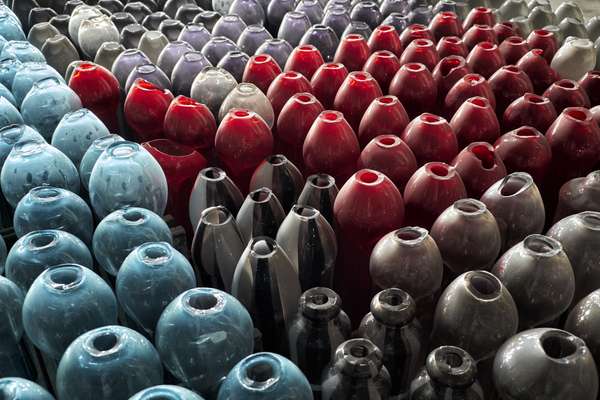
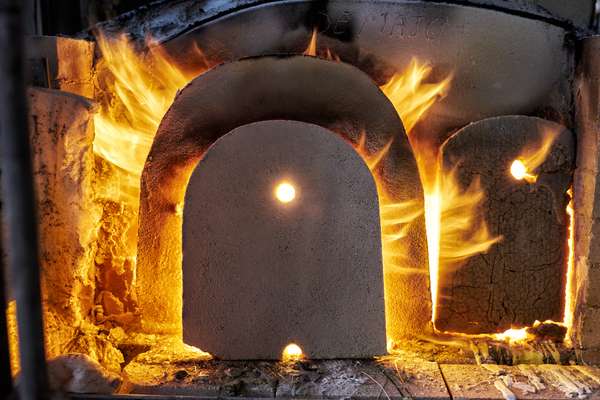
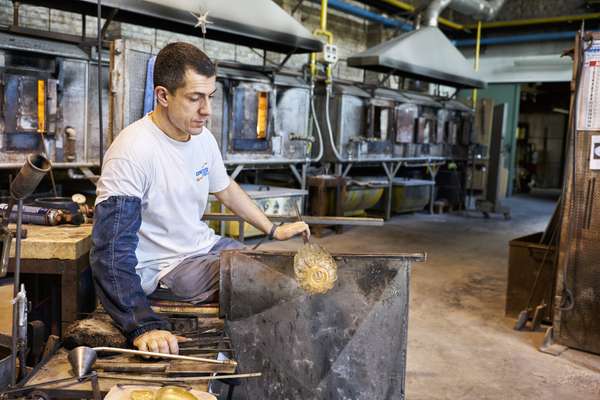
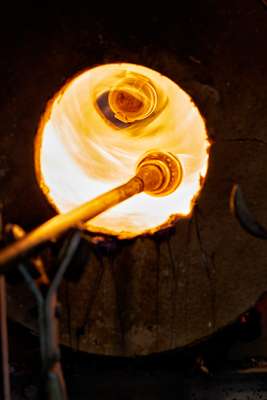

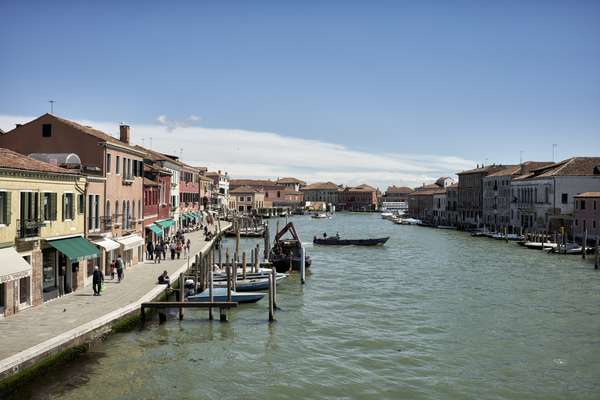
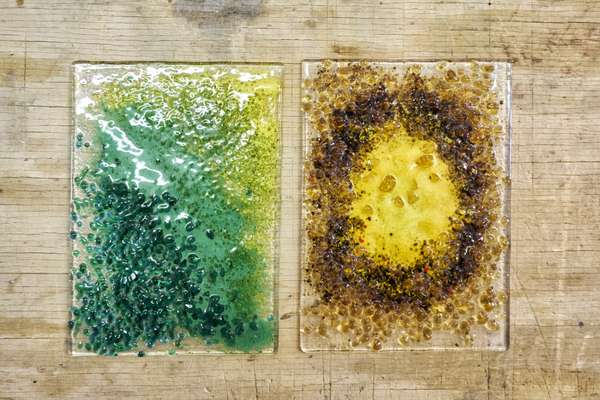
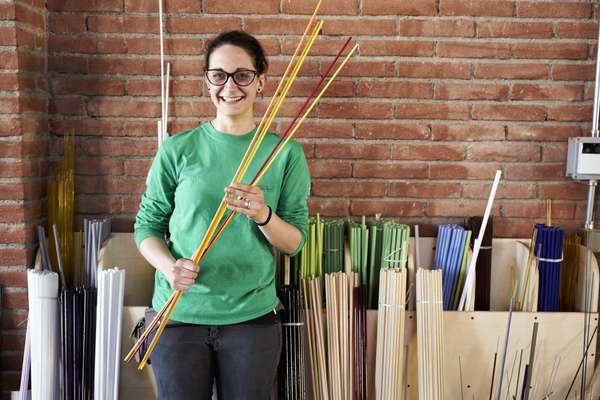
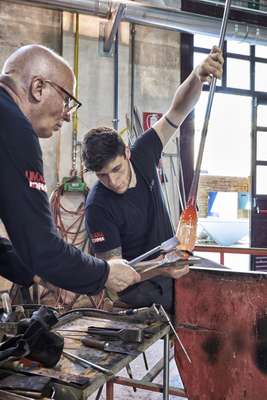
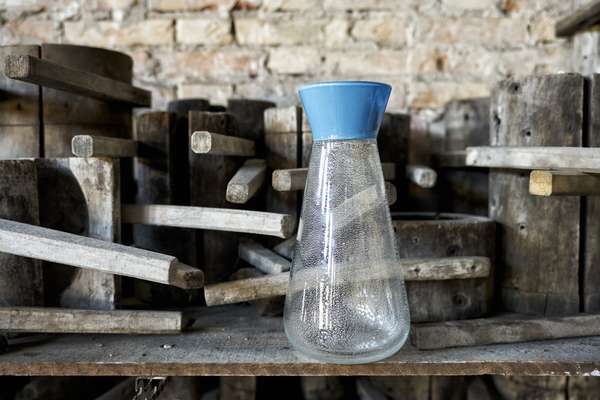
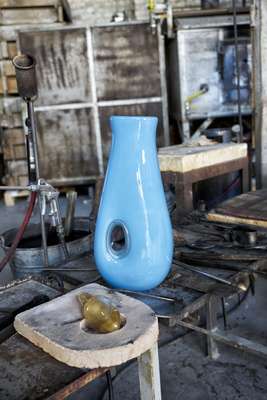

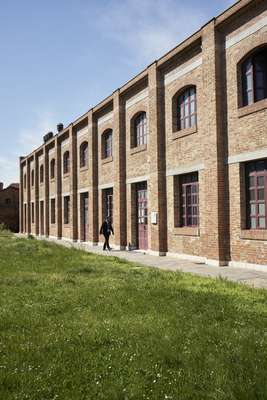
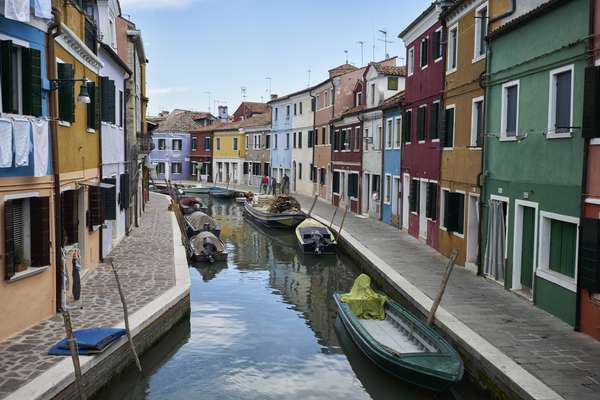
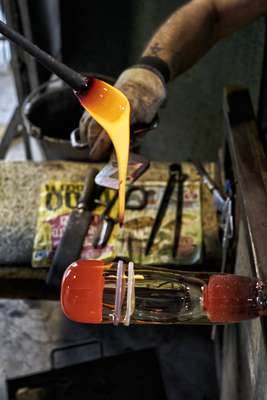
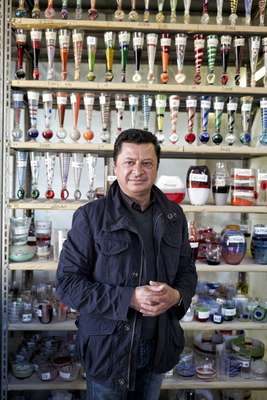



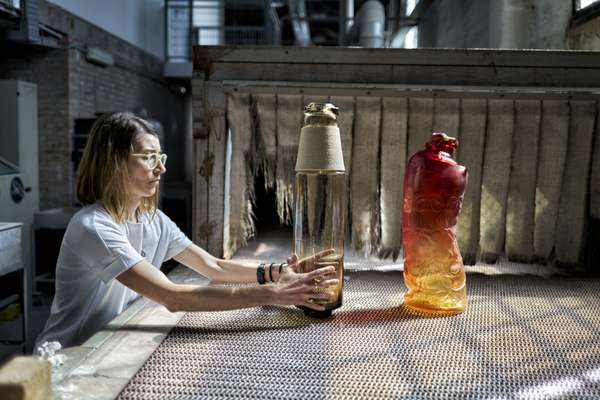
Following popular exhibitions in Berlin, London, Venice and Milan, Salviati brought the collective into the fold. Now their fresh ideas will redefine the historic glass studio’s entire catalogue. Breaking the Mould is working with Salviati’s team to draw from the company’s archive and find forgotten pieces ripe for an update, bringing in consultants from Austria, the UK, Turkey and Italy. “We are carrying out an archeological dig to unearth examples for the future,” says Coppola while 38-year old glass-blowing maestro Andrea Santuri replicates pieces selected from the archive that will serve as prototypes to be reconfigured by the collective’s team. “We are reappropriating Salviati’s past to push the material’s limits.”
Importing foreign know-how has never been Murano’s approach – and nor will it be the island’s salvation. Luckily, growing up in the island’s workshops, some young Muranesi have both familiarity with glass and the crackling spark of new ideas. Thirty-year-old Stefano Bullo completed his first stained-window composition – an elaborate floral design – when he was only 14 and later trained as a painter at Venice’s Fine Arts Academy. But window-making pulled him back: in 2014 he took over Vetrate Artistiche Murano, the company his mother and father had founded 30 years before.
Today, from his workshop on the narrow backstreet of Ramo San Bernardo in the centre of the island, Bullo patiently fits transparent and rose-tinted mouth-blown glass segments onto lead frames in a precise geometric jigsaw. His work applies a contemporary-art background to his parents’ ancient trade. During last year’s European Glass Experience exhibition he teamed up with video artist Ester Marano to create an installation projecting film onto glass sheets, which were made by glass-fusion expert Nicola Moretti.
It is with Moretti that Bullo is devising a project that he’s aiming to release at next year’s Salone del Mobile. “I realised the artistic potential of this medium,” he says. “My parents used to make very traditional windows – either octagonal or art nouveau style. I want to move into figurative designs. I’m working on original patterns, I want to use glass dots like pixels.”
For the time being Bullo combines this design-led work with restoration projects. His hands move quickly and precisely as he works on some imposing windowpanes for the Palazzo dei Camerlenghi at the very foot of Rialto Bridge. His knowledge, it seems, lives in his hands. “There’s a concept here called rubar con l’ocio: stealing with the eye,” he says. “Nobody teaches you anything. You look, you try to figure out how it’s made. You’re never sure you’ll get there the same way and everyone finds different solutions. That’s where the possibility to experiment comes from.”
This unspoken rubar con l’ocio has been Murano’s strength – but in some ways it is also its weakness. In the age-old furnace rooms no instructions or guidance are ever uttered. Metal straws topped with 1,100c glass get swung around with no word of warning – intentions are read and gestures anticipated. Each maestro works with his helpers, who follow a hierarchical structure as medieval as the craft itself. It’s a poetic process. Yet there’s a growing acknowledgment that structured teaching methods to show novices how to approach this viscous material may be key to the industry’s survival.
Though short courses in glass-making have been running at Murano’s Abate Zanetti school for 154 years, the institute recently took the decision to reinvent itself as a formal education body for Venetian pupils who can study for a high-school diploma alongside glass-making masterclasses. This September, Abate Zanetti will become the island’s first fully accredited secondary school. “Over five years it will be much easier to deepen the students’ knowledge,” says glass-fusion teacher Elena Menegazzo as she composes a design using bright blue and green glass chips.
As well as literature, maths, history and eight more subjects, the new students will study weekly workshops from glass-bead turning to finishing to prep them for working with glass. “It is our contribution towards the rebirth of the industry,” says director Martina Semenzato as she sits in the school’s glass-fusion lab by a large desk covered in traditional murrine: little patterned glass discs. “It will make for a piece of Murano’s history.”
Rescuing the island’s future can’t just be in the hands of those who manipulate fiery glass: savvy strategists will also be lifesavers for such a costly industry. “Running a business on an island is no mean feat,” says Luciano Gambaro, who heads the glass-making consortium Promovetro as well as his own brand, Gambaro & Tagliapietra. “Expenses are between 35 and 40 per cent more than on the mainland. Yet the Muranesi understand that crises have to be weathered.”
This has been done before. When the horizon turned dark in the 1850s, clergyman Zanetti rescued Murano’s industry by opening a glass museum that would show the world the island’s past and present wonders. Prosperity in the 1950s came as crowd-pulling masters such as Finland’s Tapio Wirkkala and Venice’s Carlo Scarpa were called upon to bring their modern designs to the furnace. But now the island needs a fresh boost of energy and ideas. “After 50 years Murano has paid the price of the full belly it had,” says Gambaro. “This past decade shows us we need to go forward by changing the dynamics. Sure, a crisis is depressing but it also shakes you up.”
For the design-conscious Muranese heavyweights that flourished in the 1950s, sometimes it’s just a matter of refocusing. Rather than scrambling for new ideas, Carlo Moretti, founded in 1958, needed a streamlining of its strong Nordic-inspired (but ever-expanding and cluttered) catalogue to make production less challenging. Entrepreneurs Antonio Ceschel and Manuel Gomiero took over the company from successor-less brothers Carlo and Giovanni Moretti in 2013 and started the cull. “The catalogue included about 1,200 different models,” says Ceschel. “Now we have 540 – each decision was a pang in the heart but it had to be done if we wanted to go international.”
Ceschel’s tight edit was a market success. At first supplying the vast majority of its products to the Italian market, the company now exports about 70 per cent of its colourful vases, chalices and glasses. A shop in Tokyo’s Ginza has joined outposts in Murano, Venice, Milan and Kitzbühel. Yet all the delicate vessels lining their shelves start life in this waterfront furnace room at the hands of the four masters and their helpers – some as young as 20. For all its lofty global ambitions (including a lighting collection that debuted at trade fair Euroluce’s last edition) Carlo Moretti realises the need to remain staunchly small-scale, faithful to the tradition that bred it.
Many believe that by shedding some of the weight of convoluted decorative arabesques – but sticking to the methods behind its century-long success – Murano glass may once again wade through this low tide. “If the production of Murano’s tacky glass horses needs to stop then so be it – it doesn’t have to continue just for the sake of emptying tourists’ pockets,” says Breaking the Mould’s Berrone. “We are not presenting the definitive solution but we are showing that alternatives are possible.” With such vivacious minds tending to the fire, the island isn’t anywhere near losing the ebullient spirit of its craft.
Monocle comment:
Many established designers turn to Murano’s expertise for the chandeliers and vases they present at Salone del Mobile and beyond. But these creatives shouldn’t use these furnaces simply as their manufacturing plants, delivering ideas and collecting ready-made products weeks later.
Glass-blowers’ expertise goes well beyond their practical abilities: their deep knowledge of the medium – and how far it can be stretched – can and should be incorporated into the creative process. Muranese companies need to convince external designers to stay a bit longer, ideally enlisting them as creative directors. Over time the union between forward-looking ideas and solid traditions will melt even the most reticent glass-blower. With a progressive vision it would be easier to move onto bigger and better things, such as challenging architectural interior projects – even if that means dropping a few little ornaments along the way.


